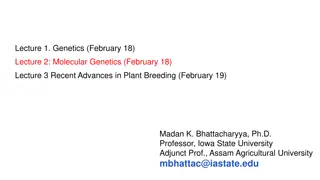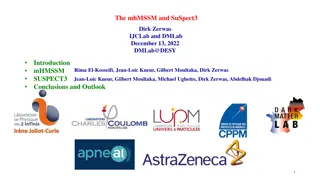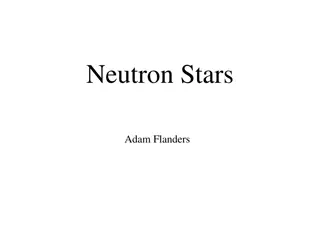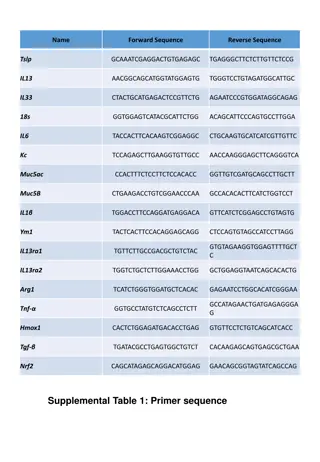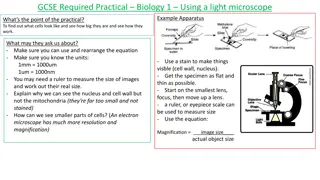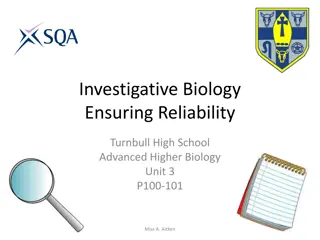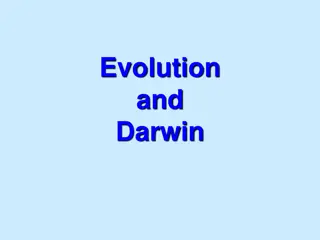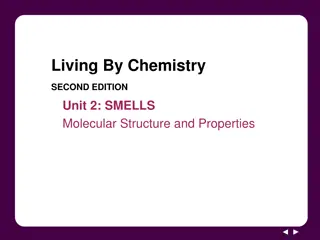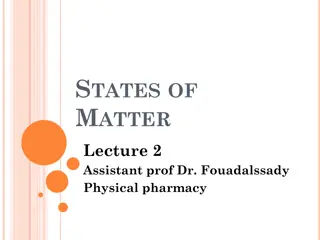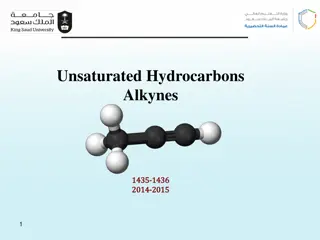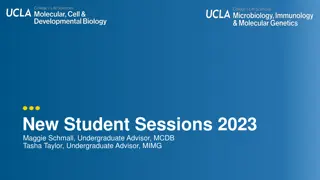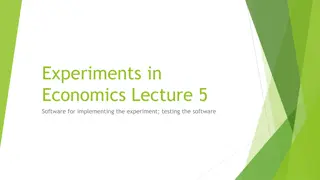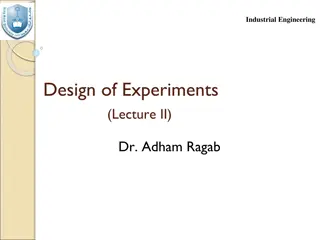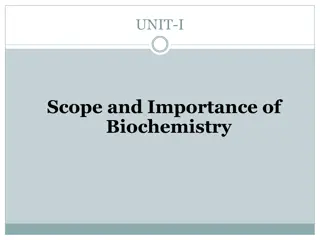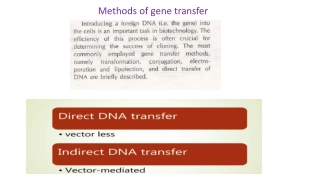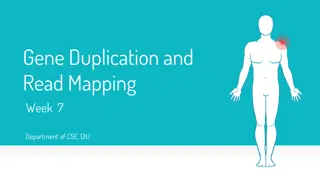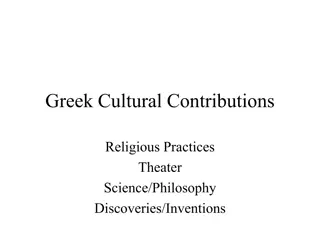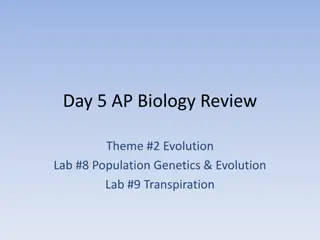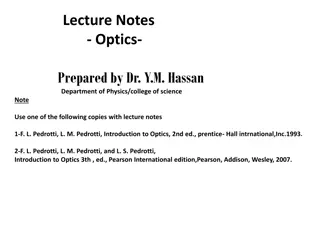History of Molecular Biology: Key Experiments and Discoveries
This content covers the introduction and brief history of molecular biology, highlighting key experiments such as the work of Freidrich Miescher, Griffith's transformation experiment, and Avery-MacLeod-McCarty's proof of DNA as the genetic material. It explores the early understanding of macromolecules like DNA, RNA, and proteins, shedding light on the foundational studies that paved the way for contemporary molecular biology.
Download Presentation

Please find below an Image/Link to download the presentation.
The content on the website is provided AS IS for your information and personal use only. It may not be sold, licensed, or shared on other websites without obtaining consent from the author. Download presentation by click this link. If you encounter any issues during the download, it is possible that the publisher has removed the file from their server.
E N D
Presentation Transcript
Molecular biology first and second lectures Introduction and brief history B y Dr. Sawsan Sajid Al-Jubori References : 1-Essential of molecular biology by George M. Malacinski 4th edition 2-Second references: Molecular biology (principles and practice)
Definition of molecular biology : It is the science deals with macromolecules and to understand the five basic behaviors patterns(growth , division , specialization ,movement and interaction)in terms of the fine molecules responsible for them including (DNA ,RNA and Protein) Freidrich Miescher (1869) : He was the first researcher who isolate and identify nucleic acid. It was a phosphate-rich chemicals, which he called nuclein (now nucleic acids), from the nuclei of white blood cells without knowing it responsibility about inheritance.
Griffiths experiment to identify the genetic material(bacterial model) Griffith's experiment, reported Griffith(british scientist) was one of the first experiments suggesting that bacteria are capable of transferring genetic information through a process known as transformation but he didn't realized the nature of the genetic materials Griffith used two strains of pneumococcus (Streptococcus pneumoniae)which is gr+ bacteria (smooth) and type II-R (rough) strain. The III-S strain covers itself with a polysaccharide capsule that protects it from the host's immune system, resulting in the death of the host, while the II-R strain doesn't have that protective capsule and is defeated by the host's immune system. in 1928-29 by Frederick infect mice a type III-S
Griffith's experiment discovering the"transforming principle" in Streptococcus pneumoniae bacteria
AveryMacLeodMcCarty Experiment to prove the DNA is the genetic material It was reported in 1944 ( as first described by Griffith's experiment in 1928) by Oswald Avery, Colin MacLeod, and Maclyn McCarty, to proof that DNA is the substance that causes bacterial transformation. They repeated the same steps of Griffith as it Start with 1- heat -killing Streptococcus pneumoniae ( virulent strain type III-S,) -2- incubation along with living but non-virulent type II-R pneumococci, -3- resulted in production of smooth colonies on media and a deadly infection of type III-S) -4-then they designed new experiment depending on cell filtrate rather than the whole cells as follow
Avery and his colleagues material responsible for heredity by transformation process 1-They start with distraction cells of virulent s strain to release the genetic material out side the cell then they took the extract and subjected to centrifuge to get red from all intact cells 2-They incubated the extract with R strain in cooled condition(4 c ) with the addition of CaCL2 (heat shock) The results showed that the R strain convert to S strain after culturing on agar media. They repeat the experiment by using only the DNA they notice the R strain converted to S strain In the second experiment they used polysaccharide instead of DNA the result was differ cos the R didn t transform to S Finally they treat cell filtrate of S strain with protease and ribonuclease and deoxyribonuclease the process succeed with the first two enzymes but is inactivated by treatment with the third one. ) (start to prove DNA is the genetic then transfer to 42 c
Final conclusion 1-The chemical analysis for the transformed cell contain nucleic acid rather than protein or polysaccaride 2-The physical analysis revealed that the nucleic acid was highly vicious rich with phosphoric acid Incubation the extract with Trypsin (protease) or RNase didn t stop transformation process and only DNase cause complete inhibition to the process thus they realize that the genetic material is the DNA rather than RNA or the protein 3-The final process called Transformation (1944) . .
HersheyChase experiments to prove that the DNA IS the genetic material using Alfred Hershey and Martha Chase (1952)confirming that DNA was the genetic material (first demonstrated in 1944) using T2 phage virus The phage consists of a protein shell(capsule) containing its genetic material(DNA). The phage infects a bacterium by attaching to its outer membrane by tail fiber then leaving its empty shell attached to the bacterium. virus (phage) model injecting its genetic material
ERPIREMENT: They depend on the differences between protein &DNA chemical structure (DNA contains :C, H,O,N and Ph while protein :C,H.O.N,S) In their first set of experiments, Hershey and Chase labeled the DNA of phages with radioactive Phosphorus- P32 (the element phosphorus is present in DNA but not present in any of the 20 amino acids from which proteins are made). They allowed the phages to infect E. coli, and through several elegant experiments were able to observe the transfer of P32 labeled phage DNA into the cytoplasm of the bacterium In their second set of experiments, they labeled the phages with radioactive Sulfur-35 (Sulfur acids cysteine and methionine, but not in DNA). Following infection of E. coli they then sheared the viral protein shells off of infected cells using a high-speed blender and separated the cells and viral coats by using a centrifuge. After separation, the radioactive S35 tracer was observed in the protein shells, but not in the infected bacteria, supporting the hypothesis that the genetic material which infects the bacteria was DNA and not protein. is present in the amino Hershey shared the 1969 Nobel Prize in Physiology or Medicine for his discoveries concerning the genetic structure of viruses.
Another important findings in molecular biology science 1950 Rosalind franklin& Maurice Wilkins (using X-ray crystallographic equipment to solve the DNA problem at King's College\London dimensional structure of the DNA or protein, according to this, A- DNA & B- DNA were described. (1953)James Watson discovered DNA molecule (will be discussed latter ) depending on franklin Wilkins X-ray model.This was one of the most significant scientific discoveries of the 20th century Francis Crick in 1958 established the theory of central dogma of molecular biology that is to say the genetic information follow from DNA RNA PROTEIN to determine the 3 (USA) &Francis Crick\UK
Rosalind franklin 1950 Maurice Wilkins 1950 James Watson(USA)&Francis Crick\UK 1953
1977 Frederick Sanger and 1980 Maxam Gilbert:are a scientists who was work on the determination of base sequences in nucleic acids". 1983 Kary Mullis American chemist start synthesis a desired DNA sequence and to copy it using polymerase chain reaction ( PCR Technique discussed latter ), a technique which would allow a small strand of DNA to be copied almost an infinite number of times. This has created revolutions in biochemistry, biology, genetics, medicine and forensics. molecular
Kary mullis receiving his Nobel price Frederick Sanger August 13, 1918 (age 95), United Kingdom Sir Martin Evans Bioscience school cardiff university Nobel price 2007
biological system as experimental models Bacteria :Prokaryotes unicellular free living cells. only one single chromosome not enclosed inside nucleus but it is free within the cytoplasm called nucleoid .the size of Escherichiacoli(E.coli) is about 4,639,221 base pair (bp )or 4.6 Kbp ( model to be used for many reason like easily to be cultured , relatively simple in their needs , short generation time (20 min for E.coli),best growth temperature 37c so it complete DNA replication ,RNA transcription and Protein synthesis within few minutes Bacteriophage: they represent the simplest form of life These infect the bacteria(there are animal ,plant human viruses) .unlike the bacteria, they are not free living (completely inert )once they enter the host they start replication depending on the machines of the host cell .it now used as cloning vector Yeast: another experimental model but for Eukaryotic cell thus it contains chromosomes within a true nucleus surrounded with nuclear membrane .great deal of early biochemical research was carried out specially fermentation process ..now for molecular biologist, mutant strains of yeast often used to discover genes that control growth ,division ,and cell behavior. Animal and plant cell : also could be used as a model in genetic experiments ) .it represent the best







